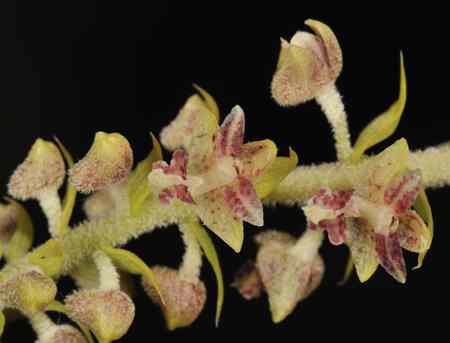The Plant
Terrestrial. A robust plant from the region, attains height between 1.5 and 2.25 ft. Stem stout, clothed in the lower portion with two blunt, clasping sheaths. Leaves 4 to 6 arranged close together at the apex of the stem, ovate with pointed apex, stalkless and with clasping bases, short sheathed, 4 to 6 cm long and 1.5 to 2 cm in width, veined with dull yellow broad margins on its upper surface. Flowers small, in spike, many, closely arranged, peduncle narrow than the stem and also with two lanceolate acuminate bracts. Tubers oblong, hairy.
The Flower
Flowers small, around 1 cm across. Sepals sub-equal, dorsal broad, concave, lanceolate and arching; lateral pair twice longer as that of the dorsal, wider at the base, spreading, oblong, obtuse, with undulate margins and folded inwardly. Petals broadly concave, blunt, larger than the dorsal sepal, connivent with the dorsal sepal to form a hood. Lip slightly shorter or of the same length of the lateral sepals, three lobed, middle lobe with blunt apex, side lobes narrow with pointed apex. Floral bracts narrow, lanceolate, erect and arising from the lower side of the ovary. Flowers sweet scented.
Sepals pale brownish pink with minute white margins. Petals greenish white with darker apex. Lip of the same shade as that of the petals, with darker shades on the apex of the three lobes. The disc of the lip got an elongated greenish brown marking on its base.

The Pursuit
A plant with sweet scented flowers. I spotted this plant with its scent only. I was camping in a protected area of the forest in the early monsoon months. As that was my first visit to that particular region, every day I crisscrossed the forest in search of new species. Early monsoon showers help a lot of plants to spurt up, as a researcher the spurting up of various plants is a great botanical phenomenon to observe. Every day before my scheduled flower hunt with my assistant, I take short trips to the forested area to watch and observe those new growths and study different plants. On one of those sunny mornings, as usual I was out with my illustrated dictionary to look for some unusual plant structures and sensed some sweet fragrance from the area. The fragrance was so soothing and nice; I was tempted to find out its source. I assumed it might be from some night flowering plants. I started looking around for it and found four plants right in front of me in full bloom. It was an unforgettable experience. In general, plants got bright coloured flowers and sweet scent to attract pollinators, today the same science made the flower attract a researcher. I was overjoyed and went back to the camp to bring my documentation instruments and produced this beautiful photograph.
Reference:
Habenaria goodyeroides Don., Page no 326 – 327 of The Orchids of the Sikkim-Himalayas by Sir. George King and Robert Pantling (1898).
